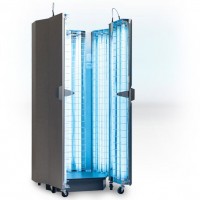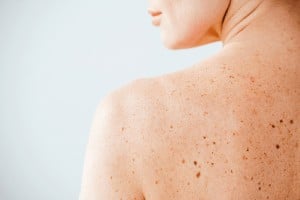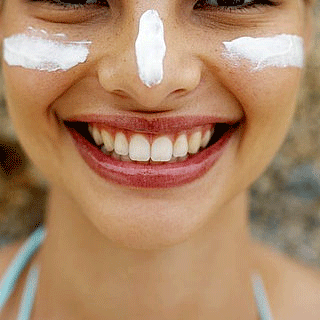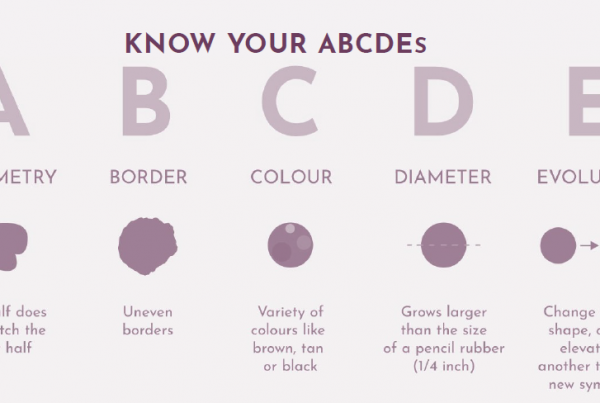
Phototherapy is a treatment that uses UV light to relieve inflammation and other symptoms of skin conditions. You might be aware that it is the UV in sunlight that can cause problems such as skin ageing and cancer. Is it safe to use this kind of light to treat your skin condition?
What is Phototherapy?
As the name suggests, phototherapy is a treatment that uses light to treat skin problems. If you have a condition like eczema, you might have noticed that it actually gets better when you’re getting more sunshine over the summer. Phototherapy makes this effect stronger by selecting the most effective types (or wavelengths) of light and shining them on your skin in safe way.
Phototherapy uses the portion of light known as UVA and UVB. These are two different types of UV or ultraviolet light, which is at a wavelength beyond the range that humans can see. You might be familiar with the terms UVA and UVB from sunscreen labels as these are the types of light that can burn or damage the skin.
- UVA has a slightly longer wavelength than other types of UV light. UVA in sunlight is associated with signs of ageing such as wrinkles. It can also contribute to skin cancers such as basal and squamous cell carcinomas.
- UVB has a shorter wavelength than UVA. The UVB in sunlight is the main cause of skin cancer, especially melanoma. It also plays a role in tanning and skin ageing.
Since we know that both of these types of UV light can damage our skin, it might seem risky to use them to treat conditions like eczema and psoriasis. However, when they are used by an experienced dermatologist it is possible to get the benefits of light therapy without harming your skin. Some people may develop a tan or experience some redness after phototherapy, but the treatment is carefully controlled to keep you safe.
However, there is still a small potential risk of skin ageing and skin cancer, especially if the treatment isn’t performed properly. Your dermatologist will explain the risks in detail so that you can make the right decisions about your care.
Risks of Phototherapy
Phototherapy can cause some minor side effects such as tanning, freckling, redness of dry skin.
The type of UV light that is used for phototherapy could also cause:
- Skin cancer (including BCC, SCC and melanoma)
- Actinic keratoses
- Sun spots
- Wrinkles and other signs of ageing
However, it would take a lot of UV exposure to cause these problems. Over the course of your life, you will be exposed to much more UV from the sun than you are during your phototherapy sessions. It would take at least 300 treatment sessions to start increasing the risk of any of these issues. A typical course of therapy might include 10-20 sessions.
Having phototherapy is therefore a bit like having an X-ray. We know that X-rays can be harmful. The type of radiation that is used to see inside your body can damage the cells and increase the risk of cancer. However, it is still safe for you to have X-rays when necessary, as long as you don’t have too many of them.
The 3 Types of Phototherapy
The UV light used during phototherapy is very carefully controlled. Your dermatologist will choose the right wavelengths, intensity and duration to treat you safely and effectively.
- Broadband UVB Phototherapy:
Broadband phototherapy uses the whole range of UVB light. It is often used to treat eczema and psoriasis, especially if your symptoms are relatively mild.
- Narrowband UVB Phototherapy:
Narrowband phototherapy only uses some of the UVB wavelengths of light. It is the most commonly used form of phototherapy and can be used to treat relatively severe cases of conditions like psoriasis. Even though it uses a smaller range of wavelengths, narrowband phototherapy can actually be more effective than broadband therapy.
- PUVA (Psoralen and UVA) Phototherapy:
PUVA treatment combines UVA light with medication that can make your skin more sensitive to the light. The medication is called psoralen. It can be taken either as a tablet or a lotion that is applied to your skin before the treatment. You will need to be even more careful to protect yourself from the sun if you’re having PUVA as your body will be much more sensitive to light.
Minimising the Risk
Whichever type of phototherapy you’re having, your dermatologist will take precautions to ensure that the treatment is as safe as possible. Although the risk of skin cancer is very low, it can be reduced even further by these safety measures:
- You won’t be offered phototherapy if you are at higher risk of skin cancer, for example if you have had it before
- The treatment will be adapted to your skin type, so you’ll get a lower dose of UV if you have fair skin that burns easily
- Your skin’s response to UV will be tested before your first treatment so that the dose can be adjusted to suit your skin
- The effects of the treatment will be monitored so that the dose can be adjusted according to how your skin responds
- Careful records of your phototherapy sessions will be maintained so that your dermatologist can limit the total amount of UV exposure
Protecting your skin from the sun in between treatment sessions can also help to minimise the risk. Your skin will be more susceptible to sun damage while you’re having phototherapy, especially if you’re undergoing PUVA. You should protect yourself by:
- Try to stay out of the sun as much as possible, especially if you’re having phototherapy during the summer
- Cover up and wear sunscreen for at least the first 24-48 hours after each treatment session
- Don’t sunbathe or use a tanning bed
- If you’re taking psoralen tablets (rather than using a lotion) then you should wear sunglasses too as your eyes will also be more sensitive to light
Do you have any more tips for protecting your skin during phototherapy?




